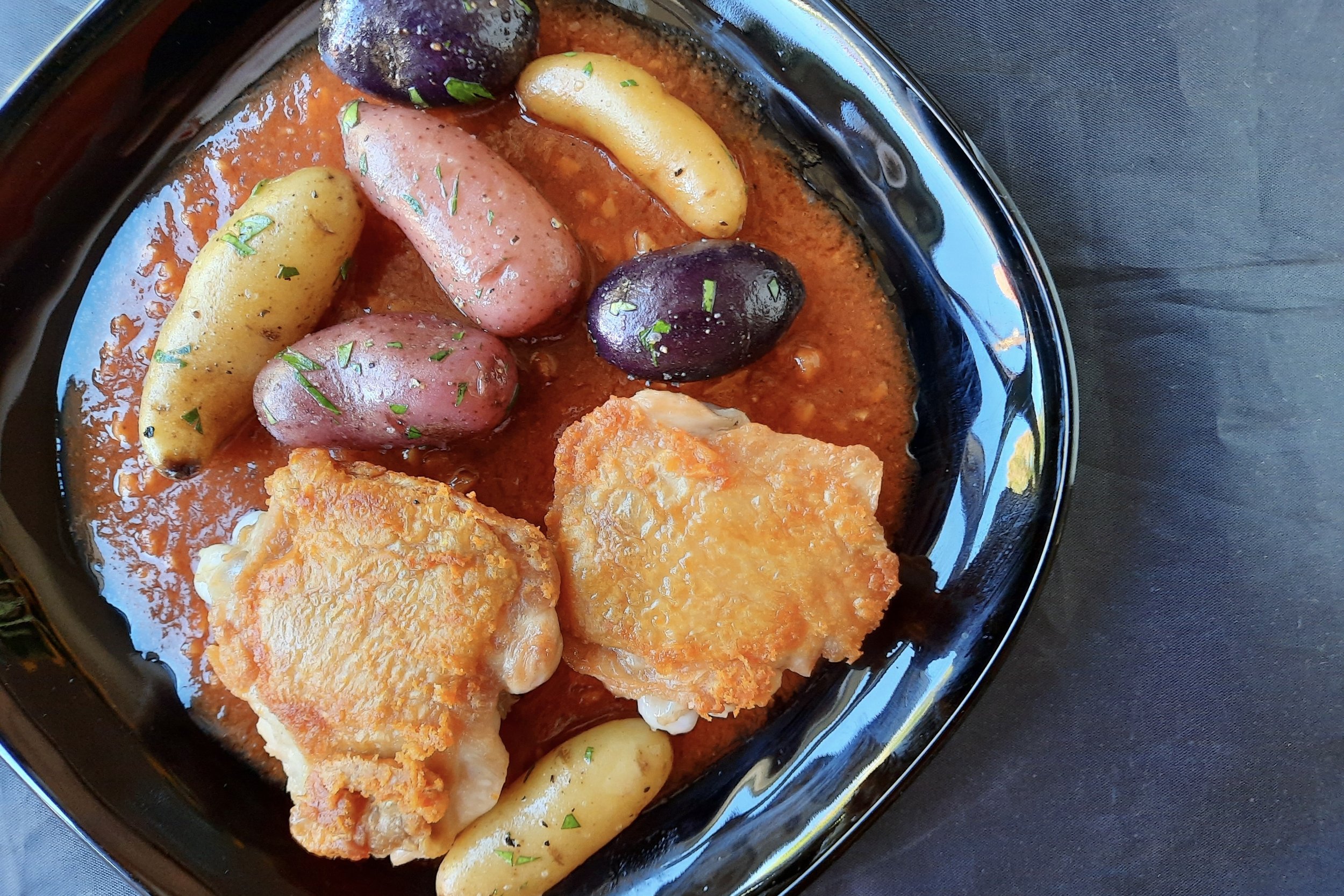BEING A COMPLEAT HISTORY OF FRENCH COOKING
A recipe for Poulet au Vinaigre (Chicken in Vinegar) follows this short hysteric . . ., um, history.
This, being a compleat history of olde French cooking.
In 52 B.C., Vercingetorix, king of the Gauls, impatient that his haunch of venison to be roasted had yet to feel the fire, snatched it from his cook, began to eat it raw and invented steak tartare.
Hubert H. Hubert, a 5th-century peasant living in a straw-thatched, dirt-floored hut in what later would be called the Midi, marked the 1,000th day in a row of cooking in and eating from the stoneware pot that hung over the fire in his hearth, into which he long had tossed and mixed anything that he found edible from the nearby forest, its meadow and stream, and from his small garden plot.
He planned to cook and eat this way for another 1,000 days, and then another, something he had learned from his mother and, she, from her mother.
Hubert H. Hubert VI, a cook to a 12th-century Knight Templar, prepared an elaborate feast for his master’s birthday, consisting of several courses—all laid out at once, in the fashion of the time—of salted and smoked meats and fish, all heavily spiced, sweetened and dressed in tart sauces, the menu (to call it that) based on balancing the four “humors” of the body (phlegm, blood, black and yellow bile). The final course was a cooked, re-feathered and gilded whole swan. It was a splendid show.
The next day, to prepare something lighter and more easily digestible, he made his master a blancmange, long-cooked chicken and rice moistened with almond milk and lightly spiced, pounded into a sort of pudding, then molded into and plated as a dome.
On New Year’s Eve, 1501, Hubert H. Hubert IX noted the offerings that night from the kitchen at his family’s roadside auberge, run by decades of grandfathers before him: fresh fruit to start (called the “entrée” because it was first to be eaten), dressed in sour wine to loosen up the stomach; then a potage of vegetables and legumes; followed by hare that was roast on a spit in the inn’s hearth, napped in tangy mustard sauce; and, to end, “entremets,” portions of the family’s famed blancmange recipe and dried figs and nuts, all designed to “close up” the stomach and allow for a long, even digestion.
The table settings for the wayfarers dining that evening would be a large spoon, a knife (if they had not brought their own) and a “plate” that consisted of a large, thick slice of very stale black bread (called a “trencher”). After it had soaked up the meal’s juices, the diners ate the plate.
On a blazingly sunny day in 1564, Hubert H. Hubert XII watched as Catherine de Medici, now queen of France, departed Paris on an epic journey through the country with her son, Charles IX. The trip would last two years and was little more than a series of grand festivals meant to unite murderously warring religious factions. The fests were not gastronomic, even marginally.
Catherine did not introduce Italian cooking to France; Italy’s best cooks’ books had preceded her in France by several decades. She did not introduce the fork to the French; others did that late in her reign, despite the French feeling it was a “silly” instrument in any case.
In 1691, Hubert H. Hubert XX bought a first edition of a new cookbook by Francois Massialot, “Le Cuisinier roïal et bourgeois.” It was the first cookbook published after the Middle Ages that listed recipes alphabetically, in thematic groups and that championed what would become the great achievements of ensuing eras in French cooking: the building blocks of fonds, stocks and liaisons, as well as a well-organized kitchen.
The recipe here, though from a well-respected contemporary chef, hearkens back to medieval French cookery, given its sweet-tart saucing.
A serving of Poulet au Vinaigre (Chicken in Vinegar), a specialty of Lyons, France.
RECIPE: Poulet au Vinaigre (Chicken in Vinegar)
Adapted from Jacques Pépin, “A French Chef Cooks at Home” (Fireside Books, 1975) and from his youtube.com video of the recipe of the same name.
Ingredients
2 large or 3 small-to-medium chicken thighs, skin-on and bone-in
Kosher or sea salt and freshly ground black pepper
3 garlic cloves, peeled, smashed well and chopped fine
3 tablespoons red wine vinegar
3 tablespoons water
1 tablespoon tomato paste
Dash of Tabasco or other hot red pepper sauce
Directions
Lay the chicken thighs skin side down and cut along both sides of the bone on each, being careful not to cut all the way through to the skin, thereby loosening the bone against the meat.
Salt and pepper both sides of the thighs. Using a dark, cold, non-stick skillet with a tight-fitting lid, lay the chicken thighs in the skillet, adjust the heat to medium-high and begin searing the chicken thighs. (Do not add any oil or butter to the skillet and do not flip over the thighs during any part of their cooking.)
When the thighs release enough fat from their skins and begin to brown well, about 5 minutes, cover the skillet and lower the heat to low, allowing the covered skillet to steam-cook the thighs, 20-25 minutes.
Remove the thighs with tongs and set them aside on a warmed plate. (The skin side should be nicely browned and very crisp.) Raise the heat on the skillet to medium-high and add the garlic, stirring and cooking for 30 seconds. (Do not burn the garlic or the sauce will be ruined.)
Add the vinegar and water, stirring to loosen all the accumulated brown bits and to vaporize the acidity of the vinegar, 1-2 minutes. Add the tomato paste and hot sauce, stirring them in and thickening the sauce, 1 minute.
Serve with buttered new potatoes sprinkled with chopped fresh flat-leaf parsley.
